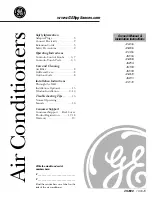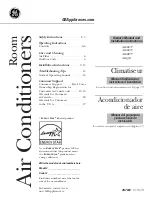
46
TROUBLESHOOTING
See Table 16 for Economizer logic. An Economizer simulator
program is available to help with Economizer training and
troubleshooting.
Economizer Preparation —
This procedure is used to prepare the
Economizer for troubleshooting. No troubleshooting or testing is
done by performing the following procedure.
NOTE
: This procedure requires a 9--v battery, 1.2 kilo--ohm
resistor, and a 5.6 kilo--ohm resistor which are not supplied with
the Economizer.
1. Disconnect power at TR and TR1. All LEDs should be off.
Exhaust fan contacts should be open.
2. Disconnect device at P and P1.
3. Jumper P to P1.
4. Disconnect wires at T and T1. Place 5.6 kilo--ohm resistor
across T and T1.
5. Jumper TR to 1.
6. Jumper TR to N.
7. If connected, remove sensor from terminals S
o
and +.
Connect 1.2 kilo--ohm 4074EJM checkout resistor across
terminals S
o
and +.
8. Put 620--ohm resistor across terminals SR and +.
9. Set minimum position, DCV set point, and exhaust poten-
tiometers fully CCW (counterclockwise).
10. Set DCV maximum position potentiometer fully CW
(clockwise).
11. Set enthalpy potentiometer to D.
12. Apply power (24 vac) to terminals TR and TR1.
Differential Enthalpy —
To check differential enthalpy:
1. Make sure Economizer preparation procedure has been
performed.
2. Place 620--ohm resistor across S
o
and +.
3. Place 1.2 kilo--ohm resistor across SR and +. The Free Cool
LED should be lit.
4. Remove 620--ohm resistor across S
o
and +. The Free Cool
LED should turn off.
5. Return Economizer settings and wiring to normal after
completing troubleshooting.
Single Enthalpy—
To check single enthalpy:
1. Make sure Economizer preparation procedure has been
performed.
2. Set the enthalpy potentiometer to A (fully CCW). The Free
Cool LED should be lit.
3. Set the enthalpy potentiometer to D (fully CW). The Free
Cool LED should turn off.
4. Return Economizer settings and wiring to normal after
completing troubleshooting.
DCV (Demand Controlled Ventilation) and Power
Exhaust—
To check DCV and Power Exhaust:
1. Make sure Economizer IV preparation procedure has been
performed.
2. Ensure terminals AQ and AQ1 are open. The LED for both
DCV and Exhaust should be off. The actuator should be
fully closed.
3. Connect a 9--v battery to AQ (positive node) and AQ1
(negative node). The LED for both DCV and Exhaust
should turn on. The actuator should drive to between 90
and 95% open.
4. Turn the Exhaust potentiometer CW until the Exhaust LED
turns off. The LED should turn off when the potentiometer
is approximately 90%. The actuator should remain in
position.
5. Turn the DCV set point potentiometer CW until the DCV
LED turns off. The DCV LED should turn off when the
potentiometer is approximately 9--v. The actuator should
drive fully closed.
6. Turn the DCV and Exhaust potentiometers CCW until the
Exhaust LED turns on. The exhaust contacts will close 30
to 120 seconds after the Exhaust LED turns on.
7. Return Economizer settings and wiring to normal after
completing troubleshooting.
DCV Minimum and Maximum Position —
To check the DCV
minimum and maximum position:
1. Make sure Economizer preparation procedure has been
performed.
2. Connect a 9--v battery to AQ (positive node) and AQ1
(negative node). The DCV LED should turn on. The actu-
ator should drive to between 90 and 95% open.
3. Turn the DCV Maximum Position potentiometer to
midpoint. The actuator should drive to between 20 and 80%
open.
4. Turn the DCV Maximum Position potentiometer to fully
CCW. The actuator should drive fully closed.
5. Turn the Minimum Position potentiometer to midpoint. The
actuator should drive to between 20 and 80% open.
6. Turn the Minimum Position Potentiometer fully CW. The
actuator should drive fully open.
7. Remove the jumper from TR and N. The actuator should
drive fully closed.
8. Return Economizer settings and wiring to normal after
completing troubleshooting.
Supply--Air Input—
To check supply--air input:
1. Make sure Economizer preparation procedure has
beenperformed.
2. Set the Enthalpy potentiometer to A. The Free Cool LED
turns on. The actuator should drive to between 20 and 80%
open.
3. Remove the 5.6 kilo--ohm resistor and jumper T to T1. The
actuator should drive fully open.
4. Remove the jumper across T and T1. The actuator should
drive fully closed.
5. Return Economizer settings and wiring to normal after
completing troubleshooting.
Economizer Troubleshooting Completion —
This procedure is
used to return the Economizer to operation. No troubleshooting or
testing is done by performing the following procedure.
1. Disconnect power at TR and TR1.
2. Set enthalpy potentiometer to previous setting.
3. Set DCV maximum position potentiometer to previous
setting. Set DVC Max potentiometer to fully closed (CCW)
when not using a CO
2
sensor.
4. Set minimum position, DCV set point, and exhaust poten-
tiometers to previous settings.
5. Remove 620--ohm resistor from terminals SR and +.
6. Remove 1.2 kilo--ohm checkout resistor from terminals SO
and +. If used, reconnect sensor from terminals SO and +.
7. Remove jumper from TR to N.
8. Remove jumper from TR to 1.
9. Remove 5.6 kilo--ohm resistor from T and T1. Reconnect
wires at T and T1.
10. Remove jumper from P to P1. Reconnect device at P and
P1.
11. Apply power (24 vac) to terminals TR and TR1.
50V
L
--
A
Содержание Performance 50VL-A
Страница 3: ...3 A09462 Fig 2 50VL A24 36 Unit Dimensions 50VL A ...
Страница 4: ...4 A09463 Fig 3 50VL A42 60 Unit Dimensions 50VL A ...
Страница 18: ...18 A10202 Fig 13 Connection Wiring Diagram 208 230 3 60 50VL A ...
Страница 19: ...19 A10202 Fig 13 Cont Ladder Wiring Diagram 208 230 3 60 50VL A ...
Страница 22: ...22 A09089 Fig 15 Cooling Charging Chart 50VL A ...
Страница 40: ...40 A10201 Fig 41 Connection Wiring Diagram 230 3 50VL A ...
Страница 41: ...41 A10201 Fig 41 Cont Ladder Wiring Diagram 230 3 50VL A ...
Страница 42: ...42 A10203 Fig 42 Connection Wiring Diagram 460 3 50VL A ...
Страница 43: ...43 A10203 Fig 42 Cont Ladder Wiring Diagram 460 3 50VL A ...





































